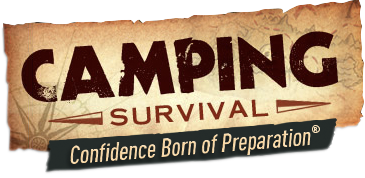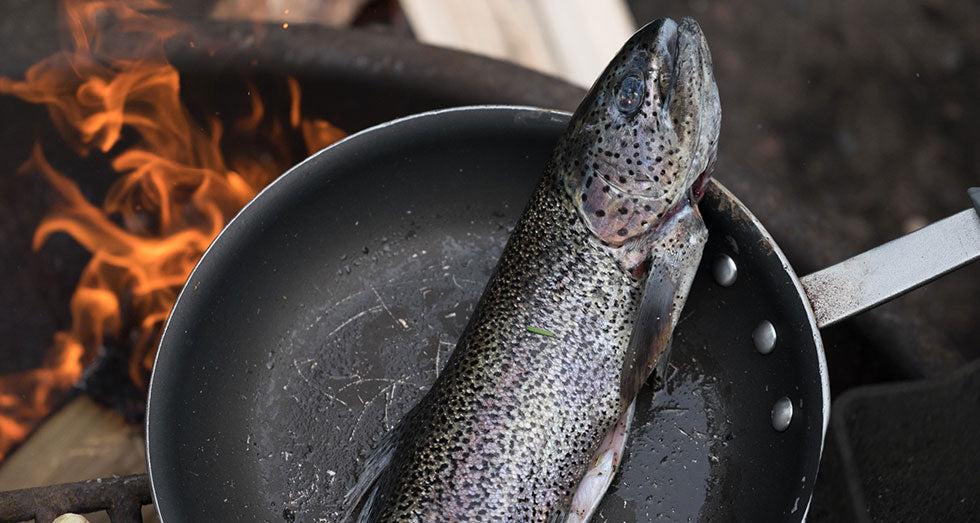It’s a small handful of skills that separate the true survivor from the day hiker, and improvised fishing is right at the top of the list.
If you have the wherewithal to rig up fishing gear in the wild, you can keep yourself alive indefinitely next to almost any body of clean water.
Today we’re going to help you up your survival game with the top 5 skills you must know to become a proficient survival angler (fisherman). These take some practice, but once you’ve mastered them, you’ll never go without food in most ecosystems.
1. The Right Places to Drop a Line

When you’re survival fishing, you should know that your options for drop points are limited. Because you won’t be able to cast out very far, you’ll need to pick your spots strategically.
Look for:
- A shallow, narrow point in a river or creek (though not so shallow that it won’t accommodate fish).
- Shoreline overhangs like docks, logs, vegetation, rock piles, and downed trees that cast shadows where fish sit and wait for food to pass by.
- Large rocks that break the current—fish will be in front and behind these points.
- Tributaries or confluences where two rivers/streams meet.
- “Drop offs” close to the shore that slope into deeper parts of a lake.
Wherever you choose to drop your line, be sure to watch your shadow. Fish are programmed to look overhead for predators and will scatter at a shadow cast on the water.
To avoid this, work the river upstream and cast your line parallel to the shore, along the bank rather than straight into the middle.
2. Make a Hook in the Wild

A Bone Hook
Search the area for animal bones and create a small pile. With a rock, smash them until you have a few pieces about the right size.
If you have a knife, use it to carve and file the bone to a hook, carve a barb to increase your hookup ratio, and notch a hole at the other end to feed your line through.
If you don’t have a knife, chip the edges of a bone shard into something resembling a hook (it may take a few tries to get this right) and then do your best to sharpen the hook. Leave a knob on the other end to tie your line around.
A Paperclip Hook
This is an easy one, but it helps to have some type of multitool handy. If not, you can do the following with your hands as well:
Cut a paperclip at about the top-middle (where the metal curves). You’ll see the shorter end forms a natural hook. Take the long end of the tip and and roll it a couple of times into a spiral. If you have a multitool or knife, sharpen the short “hook” end.
A Soda-Tab Hook
Yank the tab off a soda can. Snip one side of the tab in the middle if you have a knife or multitool; if not, you can sever it in the same location by beating it with a sharp rock.
Now twist the severed portion one-half turn. The bottom half should now form a hook. Sharpen the end on a rock.
We'd suggest using this method as a last resort. While it will hook eventually, it tends to be less effective than the other options listed here.
Straight Pin
Here’s an easy one: just bend the sharp end of a straight pin into a hook. Tie the line around the top so it catches on the pin head. Then sharpen the end. Voila!
The tough part is getting your pin to stay attached to the line...the smaller the pin head, the tougher it will be to keep it from slipping off.
An Improvised Toggle
From bone or even soft metal like aluminum, carve out a small toggle and sharpen it on both ends. Offset it just a tiny bit to one side (making one end longer than the other). Insert the bait straight into the toggle so when the fish swallows it, your little hook will turn and lodge nicely into its mouth.
3. Make Line in the Wild

When it comes to fishing line, thin and strong is the name of the game. We’ve found that especially if you’re using an improvised hook, thinner lines tend to tie and stay better.
However, that doesn’t mean you can’t use something with a little more width.
For example, paracord makes very effective fishing line in a pinch. It’s thick, but it’s strong. Just unwind the threads and you’ll have a nice set of lines that will stand up to just about anything.
You can also use shoelace, yarn, or even string unwound from clothing (though you may want to braid two or three together to add tensile strength).
Also, unless you’re in the most remote of areas, you can usually find “trash” fishing line left behind along the banks of any river or lake. These will last for years and years.
4. Find Alternative Bait

First things first: if you have any way of knowing what type of fish you’re after, you can select the bait they like most.
For example, catfish love smelly foods like cheese or hot dogs (wrap them in a cheesecloth). Walleye, auger, panfish, sunfish, and trout all loves snails and leeches.
Bread, bacon, crushed balls of cornflakes and water, canned corn, most insects, crawdads, and of course, worms, will all work in a pinch as well.
You can find aquatic bugs underneath rocks submerged in the water. Crawdads can be caught at night. You can dig for worms in the dirt near the water and under rocks. If you target a smaller panfish or sunfish, you can use them as live/cut bait to catch something bigger.
And if all else fails, you can create lures by tying paracord and fraying the ends.
5. How to Catch Fish Without a Line

We’re not going to pretend it’s easy, but there are other ways besides a line to catch fish. Trappers and native peoples have used such methods for generations. They take a little know-how and practice, but are super useful tools to have in your survival arsenal. Here are some of our favorite options, with links to tutorials that will help get you started:


4 comments
If theres a log in the water,you can wrap your arms around,you can have a feast.Lay on the log and reach around either side-give it a hug.Now wiggle your fingers like the grass or moss would,and feel around slowly-you will feel the fish,and they dont mind,since they think youre moss/grass.Now work the fish to where you can get a finger in a gill-This is easier than it sounds,then grad and of course with the hand you are most prevolent and toss it up on land.Then repeat-they will be there still.My friend and I used to catch fish like this all day.Its the easiest way.Also works if you can reach under the bank,like noodeling.I live in Idaho,so,I have done a ton of experimenting with survival tech in desert and wildernes applications.I cant spell very well though.LOL!
Awesome… I’ve watched a few survival shows, and have seen people work on them but never giving the details you gave regarding the Gill net. Thank you!
Good Information
good things to know. thanks